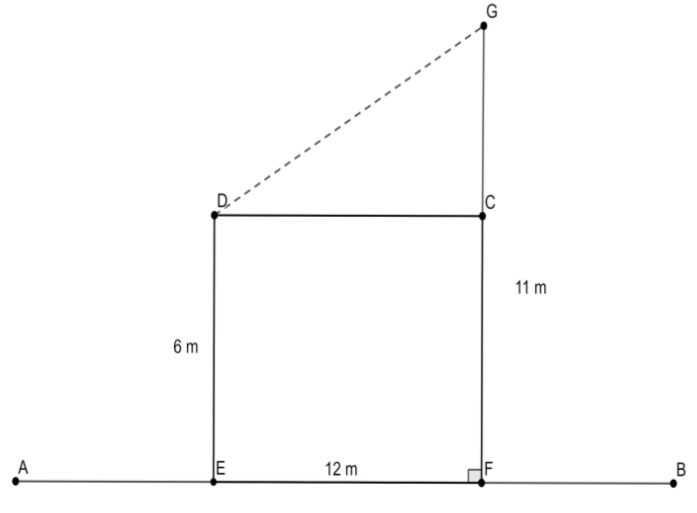
Two poles of height 6 m and 11 m stand vertically upright on a plane ground. If the distance between their feet is 12 m, the distance between their tops is
(a) 12 m
(b) 14 m
(c) 13 m
(d) 11 m
Answer
573.3k+ views
Hint: We will draw a figure to get a rough idea of the positions of the pole. We will be able to see a right-angled triangle in the figure. We have the lengths of the sides of this triangle. We will be able to use the Pythagoras theorem to find the distance between the tops of the two poles.
Complete step-by-step solution:
First, we will sketch a rough figure to understand the positions of the two poles.

In this figure, the lengths are not to scale but we can analyze the problem. We have two poles, DE and GF with lengths 6 m and 11 m, respectively. AB is the ground. The distance between the poles is EF which is 12 m. Now, we have to find the distance between the tops of the poles, which is DG.
The poles are vertically upright. Hence, the poles make the right angle with the ground. From the figure, it can be seen that DC is parallel to EF. So we have $DC=12$m and considering GF as a transversal, $\angle CFE=\angle GCD=90{}^\circ $. Also, because $DE=CF$, we have $GC=GF-CF=11-6=5$ m. Now, we can apply the Pythagoras theorem in $\Delta GCD$. The Pythagoras theorem states that, in a right-angled triangle, ${{(Hypotenuse)}^{2}}={{(Base)}^{2}}+{{(Height)}^{2}}$.
So, we have $G{{D}^{2}}=D{{C}^{2}}+G{{C}^{2}}$. Substituting the values of DC and GC, we get the following,
\[\begin{align}
& G{{D}^{2}}={{(12)}^{2}}+{{(5)}^{2}} \\
& =144+25 \\
& =169
\end{align}\]
Therefore, $GD=13$m. So, the distance between the tops of the poles is 13 m.
The correct option is (c).
Note: In this question, the figure helps us in understanding the question. Looking at the image makes it easier to find the right-angled triangle. So we can use the Pythagoras theorem and obtain the desired answer. The properties of angles made by a transversal along two parallel lines are useful in such questions.
Complete step-by-step solution:
First, we will sketch a rough figure to understand the positions of the two poles.

In this figure, the lengths are not to scale but we can analyze the problem. We have two poles, DE and GF with lengths 6 m and 11 m, respectively. AB is the ground. The distance between the poles is EF which is 12 m. Now, we have to find the distance between the tops of the poles, which is DG.
The poles are vertically upright. Hence, the poles make the right angle with the ground. From the figure, it can be seen that DC is parallel to EF. So we have $DC=12$m and considering GF as a transversal, $\angle CFE=\angle GCD=90{}^\circ $. Also, because $DE=CF$, we have $GC=GF-CF=11-6=5$ m. Now, we can apply the Pythagoras theorem in $\Delta GCD$. The Pythagoras theorem states that, in a right-angled triangle, ${{(Hypotenuse)}^{2}}={{(Base)}^{2}}+{{(Height)}^{2}}$.
So, we have $G{{D}^{2}}=D{{C}^{2}}+G{{C}^{2}}$. Substituting the values of DC and GC, we get the following,
\[\begin{align}
& G{{D}^{2}}={{(12)}^{2}}+{{(5)}^{2}} \\
& =144+25 \\
& =169
\end{align}\]
Therefore, $GD=13$m. So, the distance between the tops of the poles is 13 m.
The correct option is (c).
Note: In this question, the figure helps us in understanding the question. Looking at the image makes it easier to find the right-angled triangle. So we can use the Pythagoras theorem and obtain the desired answer. The properties of angles made by a transversal along two parallel lines are useful in such questions.
Recently Updated Pages
Two men on either side of the cliff 90m height observe class 10 maths CBSE

What happens to glucose which enters nephron along class 10 biology CBSE

Cutting of the Chinese melon means A The business and class 10 social science CBSE

Write a dialogue with at least ten utterances between class 10 english CBSE

Show an aquatic food chain using the following organisms class 10 biology CBSE

A circle is inscribed in an equilateral triangle and class 10 maths CBSE

Trending doubts
Why is there a time difference of about 5 hours between class 10 social science CBSE

Write a letter to the principal requesting him to grant class 10 english CBSE

What is the median of the first 10 natural numbers class 10 maths CBSE

The Equation xxx + 2 is Satisfied when x is Equal to Class 10 Maths

Which of the following does not have a fundamental class 10 physics CBSE

State and prove converse of BPT Basic Proportionality class 10 maths CBSE




